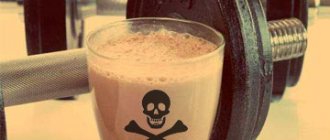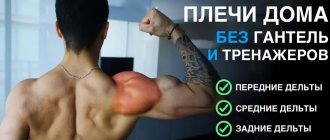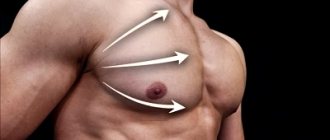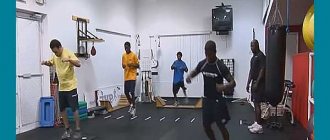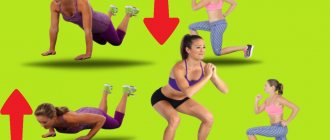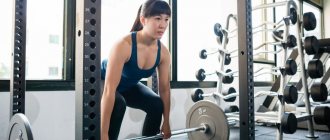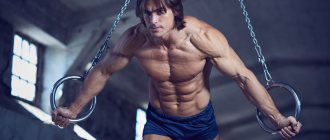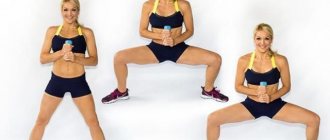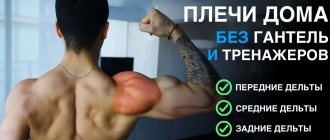Bulgarian lunges
According to training and nutrition expert Tim Liu, this is one of the exercises that can kill your legs. With it you will strengthen the muscles of the thighs, buttocks and quadriceps. In addition, performing the exercise requires good stability, which means it trains the vestibular apparatus. After some time, you will be able to use dumbbells, gradually increasing their weight.
Technique:
- Stand with your back to the bench and place your left toes on it and straighten your right leg (you can also use a stable chair, ladder or platform).
- Make sure your right leg is at a distance from the bench so that your knee does not go beyond the line of your foot as you move down.
- Start the movement: bend your right knee, contracting your left gluteal muscle, and lower your pelvis down.
- Shift your body weight to your right heel and return to the starting position.
Do the required number of repetitions and then switch legs.
Who needs it and why?
Exercises to develop strength, contrary to the erroneous belief of some people, are needed not only by powerlifters or weightlifters.
They are also necessary for bodybuilders to strengthen muscles, as well as ligaments and tendons. And for both women and men.
By increasing their strength potential in this way, they can lift more, which means they can build more muscle.
In addition, strength training helps overcome the “plateau” - a period of stagnation when the muscles refuse to progress.
Adding variety to your training routine can help you get off the ground and continue to grow.
Athletes from other sports also work on their strength levels. A striking example is martial arts and American football.
In addition, this quality will also come in handy in everyday life. Lifting a heavy package, moving an object in an apartment without getting injured is an important skill that everyone will need.
Air squats
A fairly popular exercise, most often performed in cross-fit training. According to trainer Laura Su, squats will not only strengthen your thighs and buttocks, but will also have a positive effect on your posture and the function of your stabilizing back and core muscles.
Technique:
- Stand straight, place your feet slightly wider than shoulder-width apart, parallel to each other, or with your feet slightly apart.
- Bend your knees, lowering your pelvis deeply down. Bend your elbows and rest them on your hips. Make sure your body weight is on your heels.
- Drive up by straightening your legs and squeezing your glutes to get the most out of the exercise.
Do the required number of repetitions.
see also
11 exercises for perfect buttocks
Pull-ups
This is one of the most difficult bodyweight exercises, but it does a great job of working the biceps, shoulder blade area, latissimus dorsi and core muscles. Be sure to include this exercise in your upper body workout. If you can't do classic pull-ups, try starting with an elastic band/elastic band or the Gravitron machine.
Technique: (with elastic band)
- Securely secure the tape/elastic band around the bar. To start, use a tight band with a lot of resistance - this will make the movement easier and help you lift yourself.
- Stand on a stable object (such as a bench) and grab the bar with one hand. With your other hand, place your legs in the loop of the band and pull them down.
- Keeping your back straight and your abs tense, lift yourself up using your arms. Then lower yourself down, returning to the starting position.
Do the required number of repetitions.
What is the purpose of bodyweight training?
As we have already said, pronounced muscle hypertrophy when exercising with your own weight occurs in the first 1-3 months of training.
But once you reach 15-20 reps per set, the load shifts to the slow-twitch, endurance muscle fibers.
During their development, they provide only an additional 20% of the muscle fiber volume, without significantly increasing the volume.
If you want to stimulate maximum growth, it is better to train fast-twitch, power fibers. There are much more of them in muscles, so 60% of all muscle mass depends on them. The average rep range for a workout is 6 to 15.
When regularly performing exercises in a high repetition range (20 and above), strength endurance develops more, which does not help to noticeably progress in muscle growth.
Classic push-ups
“Push-ups are truly one of the best basic bodyweight exercises that even beginners can easily master,” said Angie Ash, certified personal trainer and exercise physiologist. Push-ups are great for strengthening your upper body and core muscles, she says.
Technique:
- Get into a plank position with your arms extended. Make sure your shoulders are directly above your wrists.
- As you exhale, bend your elbows and lower your chest toward the ground. Pause as soon as your elbows form a right angle. As you inhale, straighten your arms and return to the starting position.
Do the required number of repetitions.
If you find this exercise difficult, try doing push-ups from your knees.
see also
A 3-month workout plan to get your body in shape
"Boat"
Stay in the same position, lying on your stomach. Raise your upper body above the floor, stretch your arms forward. Raise your legs, knees should be straight. Look straight ahead. Hold in this position for 10 seconds. Get down to the floor.
Number of repetitions – 5 repetitions of 10 seconds.
Advice. Breathing should be smooth and free.
Contraindications. Hernias, pain in the shoulders or lower back, problems in the cervical spine.
Alternating reverse lunges
Alternating lunges in place are an effective way to strengthen your lower body, especially your quads, hamstrings, and glutes. Additionally, by doing this exercise regularly, you will get rid of muscle imbalances and increase the strength of both legs symmetrically.
Technique:
- Stand straight with your feet together. Take a large step (lunge) back with your left foot.
- Lower your pelvis down so that your right thigh (front leg) is parallel to the floor and your right knee is directly above your ankle. Keep your left knee bent at a 90-degree angle. Make sure your left heel is in the air.
- Return to the starting position.
Change your leg. Do the required number of repetitions.
"Kitty"
Get on all fours, arms should be straight, and legs should be bent at the knees at an angle of 90 degrees. Arch your lower back, lower your head down. Feel your back stretch. Now do the opposite movement - arch your back, raising your head as high as possible. Fix at the top and bottom points for 3 seconds.
Number of repetitions – 2 sets of 10 times (with a delay of 3 seconds).
Advice. Try to strain your back as much as possible in each position, breathe evenly.
Contraindications. Lower back pain, hernia, hypertension.
Gluteal bridge
The glute bridge works well on the glutes and hamstrings, and also helps strengthen the lower back and hamstrings.
Technique:
- Lie on your back with your knees bent and your feet flat on the floor.
- Place your hands along your body, palms down.
- Pressing your heels into the floor, lift your hips as high as possible into a bridge position.
- Stay in this position for 2-3 counts, squeezing your buttocks.
- Slowly lower yourself down.
Do the required number of repetitions.
see also
10 simple exercises to keep your legs in good shape: 20 minute workout
Plank
From a lying position, rise onto your forearms and toes, straighten your knees. The back should be straight, the lower back should not bend. Direct your gaze straight ahead. You need to hold out in this position for at least a minute.
Number of repetitions – 2 sets of 60 seconds.
Advice. Breathing should be free, your back should be straight, try not to arch your lower back and keep your abs tense.
Contraindications. Hernias, sharp pain in the lower back.
Hip thrusts
The exercise is very similar to the glute bridge, but has a few differences. Firstly, push-ups are usually done while lying on a bench, and secondly, using weights (but in this case this is not at all necessary). The exercise is also aimed at strengthening the gluteal muscles, lower back and knees.
Technique:
- Lie on the bench with only your upper back, bend your legs at the knees and lower them to the floor parallel to each other.
- Press your heels into the floor and squeeze your buttocks, lifting your pelvis up. Your body should resemble a table: make sure your hips are in line with your knees.
- Slowly lower your pelvis down.
Do the required number of repetitions.
Over time, you can make the exercise more difficult by placing a barbell or dumbbell on your thighs.
Hyperextension
Let's start by warming up the back muscles. To do this, lie on your stomach, place your hands behind your head and lock them together. Elbows spread to the sides, head down, legs connected. Now lift your upper body, trying to arch your lower back. Lower yourself down without putting your head on the floor. Repeat the movement.
Number of repetitions – 2 sets of 20 times.
Advice. Do not make sudden movements; the exercise is performed smoothly.
Contraindications. Pain in the back, shoulders, problems in the cervical spine.
Straight crunches
New York-based personal trainer Reggie Chambers shared that straight crunches are one of his favorite core-strengthening exercises. With it, you are guaranteed to work your lower and upper abdominals, and also achieve an increase in heart rate, just like when doing cardio.
Technique:
- Lie on your back with your arms and legs extended.
- While drawing in your stomach and tensing your abs, simultaneously lift your arms and legs up at a right angle.
- Then lower them down without touching the floor.
Complete the required number of repetitions.
If the exercise seems difficult to you, bend your knees slightly.
Jump Squats
“Jump squats are ideal for strengthening your glutes, hamstrings, lower back, and core,” says Jackie Wilson, personal trainer, CEO and founder of NOVA Fitness Innovation Studios in New York City. Exercise will also help you develop strength and endurance, improve balance and cardiovascular health.
Technique:
- Stand straight with your feet shoulder-width apart.
- Do a regular squat, then jump up, keeping your abs tight.
- As you land, lower yourself back into a squat, completing one repetition. Try to land smoothly and control your movements.
Do the required number of repetitions.
